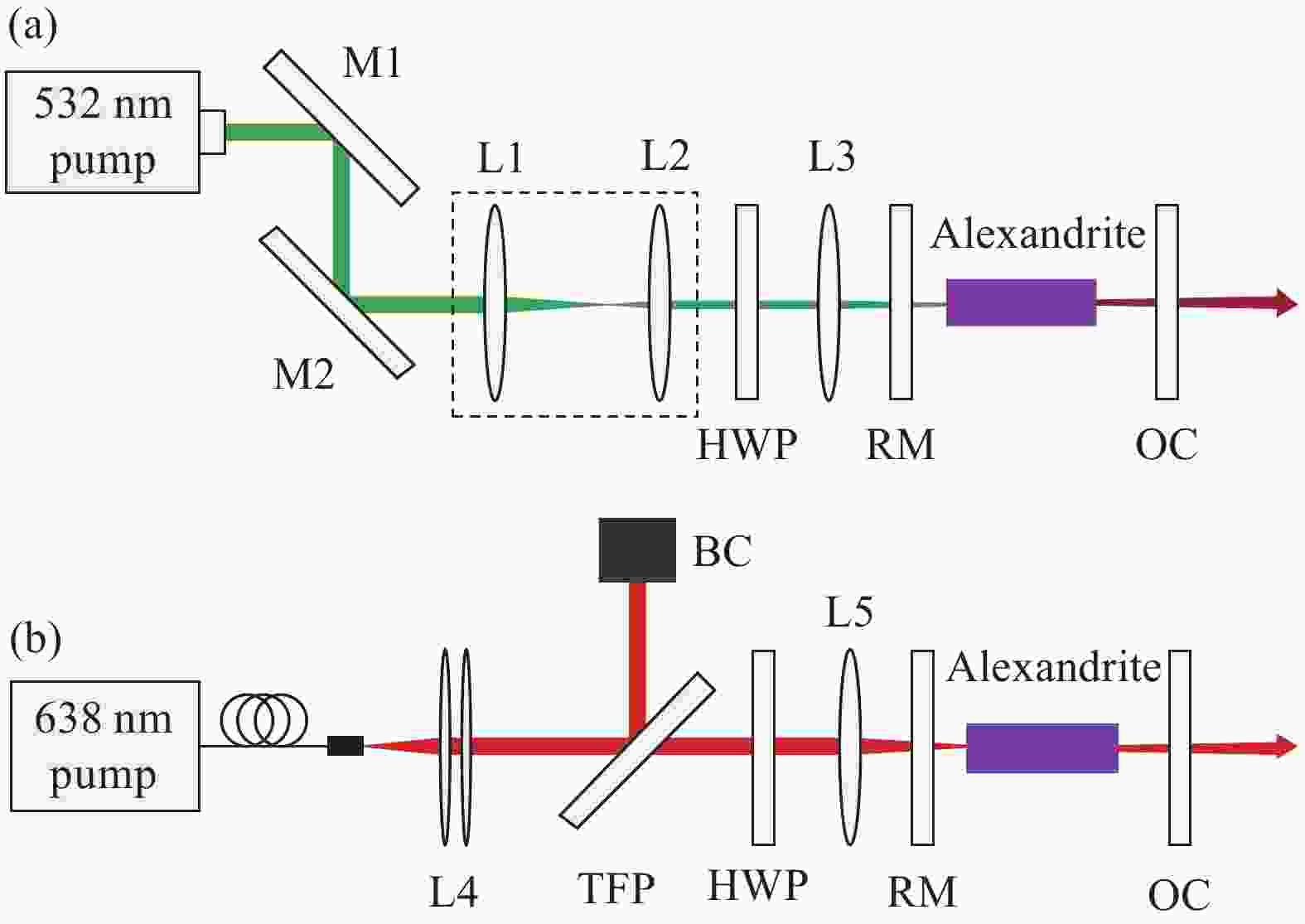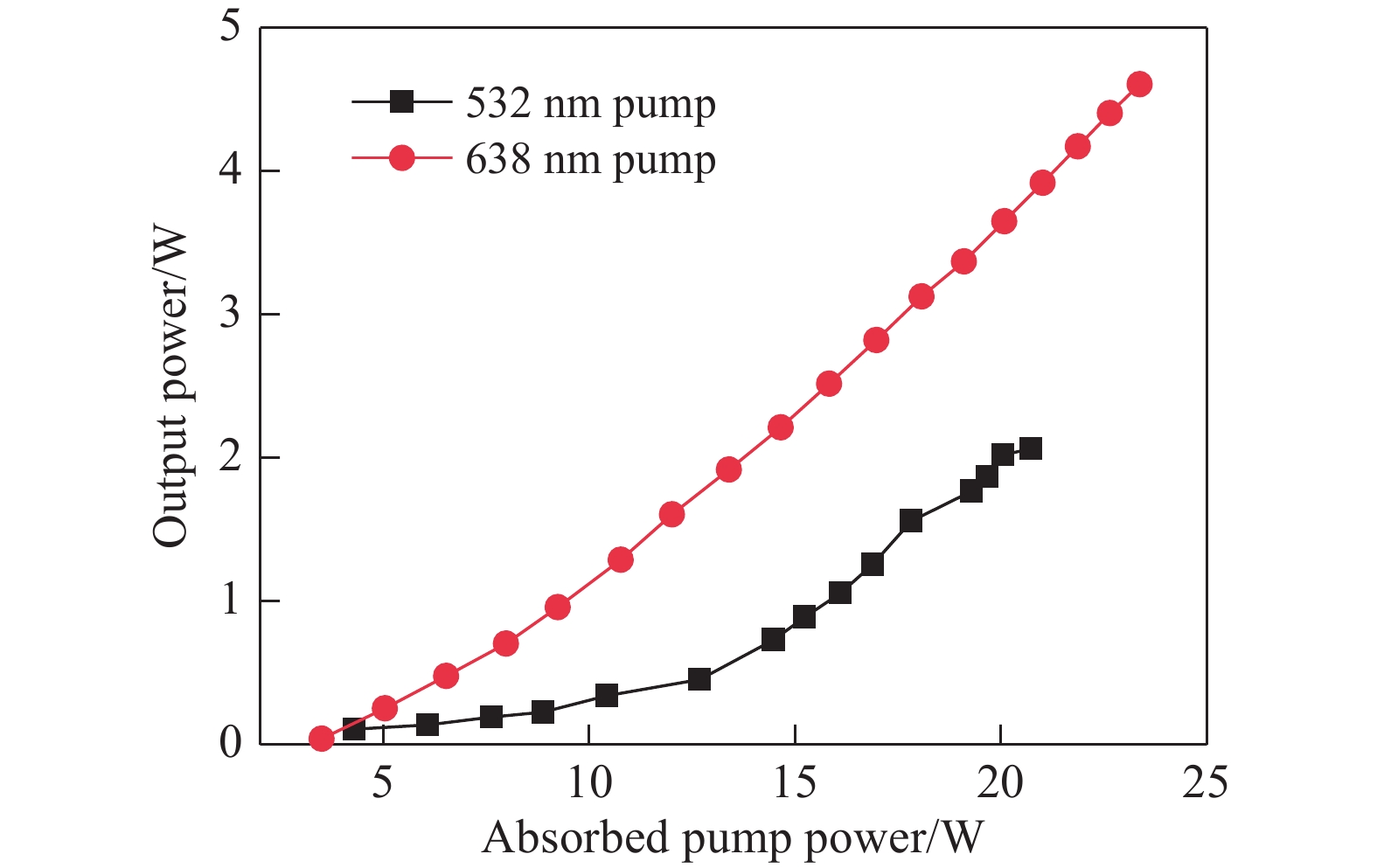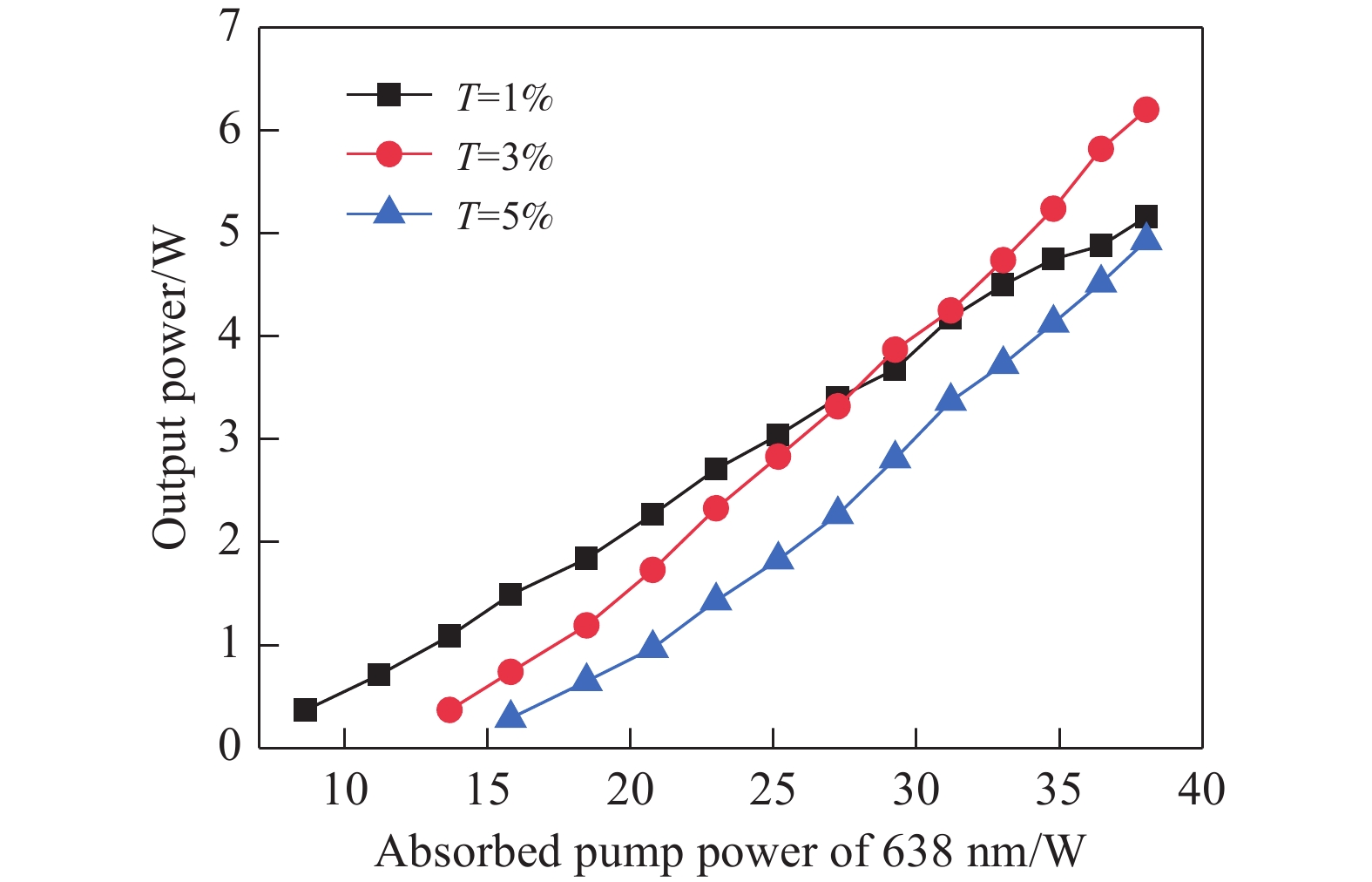-
Continuous-wave lasers have a broad application prospects in laser measurement, laser communication, scientific research and other fields[1-6], which have always aroused the research interest in them. Alexandrite (chromium-doped chrysoberyl, Cr3+: BeAl2O4) as a favorable vibronic solid-state laser material, is the first tunable laser crystal to operate at room temperature with a tunable wavelength range of 701-858 nm[7], and the broadly tunable emission spectrum makes it widely used in many applications, such as remote sensing, clinical dermatology, and lidar[8-10]. Besides, with the frequency conversion, Alexandrite can be utilized for producing efficient and stable ultraviolet lasers because of its special laser bands[11-12]. Alexandrite has many excellent qualities, for ex-ample, almost twice the thermal conductivity (23 W/mK)[7] and five-times the fracture resistance of the ‘industry-standard’ laser crystal Nd:YAG[7]. The natural biref-ringence of Alexandrite provides a linearly polarized laser parallel to the b-axis of the crystal, which makes it basically unaffected by the depolarization caused by thermal stress. The upper-state lifetime of Alexandrite is ~260 μs[7], which allows it to store energy over a long period of time, hence it is suitable for Q-switched operation. The stimulated emission cross-section of Alexandrite is just 0.7×10-20 cm2, while at the same time it has high optical damage threshold of >270 J/cm2, which allows it to efficiently extract gain with high laser fluence[7]. A significant characteristic of Alexandrite is that it has very broad absorption bands (350-690 nm) in the spectrum with two main peaks centered at 410 nm and 590 nm, allowing different pump options.
To date, a variety of pumping methods have indeed been implemented to Alexandrite. The output power of Alexandrite laser pumped by the flash-lamp is by far the highest[13], while it is difficult to improve the conversion efficiency. An Alexandrite laser pumped by a 1.9 W krypton ion laser with the CW output power of 0.6 W was achieved in 1983[14], whereas the restricted pump power makes this pumping method unable to supply Alexandrite laser with high output power. Furthermore, the Alexandrite laser, which has the highest slope efficiency to date of 63.8% and the output power of 0.15 W, was pumped by a 645 nm dye laser in 1993[15], however, because of its complex structure and low pumping efficiency, the dye laser is not positive to use for pumping. Shirin et al. demonstrated a green pumped Alexandrite laser and a CW output power obtained at 755 nm was 2.6 W, the corresponding slope efficiency was 26%[16]. According to the absorption spectrum of Alexandrite, one of the main advantages of Alexandrite is that it can be pumped directly by red LDs. The diode as a pumping source for Alexandrite has the advantages of small size, light weight, high power and so on, and the red diodes coupled with fiber were utilized to pump Alexandrite, more than 1W output power with diffraction-limited TEM00 mode was achieved[17]. Achaya et al. used high-power red diodes (at 639 nm) to end-pump the Alexandrite rod in a plane-plane mirror cavity with a cavity length of 15 mm in 2014, and have obtained a CW output power of 26.2 W in multi-mode operation while the pump power was 64.5W, the corresponding slope efficiency and optical-to-optical conversion efficiency were 49% and 40.5%, respectively[18]. William et al. used a 5 W 636 nm fiber-coupled diode module to end-pump the Alexandrite rod, and obtained a CW output power of 1.22 W at 762 nm, the slope efficiency of up to 54%[19]. A 638 nm diode module end-pumped Alexandrite laser was reported, and a CW output power of 1.7 W in TEM00 mode with a high beam quality of M2 = 1.1 was demonstrated, the corresponding slope efficiency was 36.3%[20]. A diode side-pumped Alexandrite laser in double-bounce geometry cavity was experimented, 4.5 W CW output power at 755 nm of the TEM00 mode was generated in the extended cavity, with slope efficiency of 43%[21]. Based on the above results, the LD and the 532 nm laser pumped Alexandrite lasers have been widely studied, but the high fundamental mode power has not been obtained.
In this paper, the output power and efficiency of CW 532 nm solid-state laser and CW fiber-coupled 638 nm LDs single-end-pumped Alexandrite lasers were compared in Section 1. The results show that the CW output power, optical-to-optical conversion efficiency, and slope efficiency of Alexandrite laser pumped by 638 nm LDs (3.9 W, 19.7%, and 23.7%) were higher than that pumped by 532 nm solid-state laser (2.1 W, 10.0%, and 12.9%). Additionally, when the single-end-pumped power of the LDs at 638 nm was increased to 24.5 W, a CW output power of 4.6 W at the center wavelength of 755 nm was obtained. For purpose of obtaining high-power, high-beam-quality Alexandrite laser, a fiber-coupled 638 nm LDs double-end-pumped Alexandrite laser was described in Section 2. The maximum CW output power of 6.2 W was obtained in the wavelength of 755 nm, the optical-to-optical conversion efficiency and slope efficiency of 16.3% and 24.2%, respectively. At M2 better than 1.47, a CW output power of 5.0 W was achieved, which was the highest CW output power of Alexandrite laser with the diffraction limit as far as we know.
-
The experimental setup of Alexandrite laser single-end pumped by 532 nm solid-state laser is shown in Fig. 1(a). A c-axis-cut Alexandrite crystal (Crystech Co.) with size of 3 mm×3 mm×10 mm and Cr3+ doping concentration of 0.2 at. % was investigated, which was wrapped in indium foil and tightly mounted in a water-cooled copper heat-sinks, and the temperature of water was maintained at 20 ℃. The two ends of the crystal were anti-reflection (AR) coated at wavelengths of 532 nm & 600-800 nm, with the reflectivity of <0.2%. A 22 W CW 532 nm solid-state laser was utilized as the pump source of Alexandrite, and the pump beam was collimated and compressed by a beam shaping system (L1, L2). A convex lens (L3) was utilized to focus the pump beam to spot diameter of 200 μm on the end face of the Alexandrite crystal, and the focal length of L3 was 150 mm. The polarization direction of the pump laser was regulated by the half-wave plate (HWP) to match the maximum absorption direction of Alexandrite. After adjustment, about 95% of the pump power can be absorbed by the Alexandrite. A short plane-plane cavity was adopted with the cavity length of 26 mm. The rear mirror (RM) was AR coated at the pump wavelength (~532 nm) and high-reflection (HR) coated at laser wavelengths (750-800 nm). An output coupler (OC) with transmittance (Toc) of 1% was utilized in the experiment.

Figure 1. (a) Schematic of Alexandrite laser single-end-pumped by a 532 nm solid-state laser. (b) Schematic of Alexandrite laser single-end-pumped by a 638 nm LDs. M1-M2, high reflection mirrors; HWP, half-wave plate; RM, rear mirror; OC, output coupler; L1-L5, convex lenses; BC, beam collector; TFP, thin film polarizer
Keeping other conditions unchanged, the pump source was replaced by a 40 W fiber-coupled 638 nm LDs with the fiber core diameter of 400 μm and NA = 0.22, and the schematic is shown in Fig. 1(b). Considering that the Alexandrite crystal has a strong polarization absorption of 638 nm, a thin film polarizer (TFP) was used to separate the pump beam to acquire the polarized laser, and the transmitted beam was utilized to pump the Alexandrite from the end face with the maximum power of 24.5 W. The beam shaping optics system (L4) was used to collimate the LDs beam, and can be used with a convex lens (L5) to focus the LDs beam to spot diameter of 200 μm on the end face of the crystal. The polarization direction of the pump beam was adjusted with a 638 nm HWP to keep it consistent with the direction of maximum absorption of the crystal, where the absorption rate measured was about 95%.
Fig. 2 shows the output powers varies with absorbed pump powers of Alexandrite lasers single-end-pumped by 532 nm solid-state laser and 638 nm LDs. The Alexandrite laser threshold was 4.5 W with OC of T=1% when 532 nm solid-state laser was utilized as the pump source. When the pump power was 22 W, the CW output power at the center wavelength of 755 nm was 2.1 W, and the corresponding optical-optical conversion efficiency and slope efficiency were 10.0% and 12.9%, respectively. The efficiency in the experiment is lower than that in previous report[9], which may be due to the fact that the mode of 532 nm in Ref. [9] is TEM00 mode, and the spot diameter focused to the end face of the crystal is about 44 μm. However, the beam quality M2 and spot diameter in our experiment are about 11.8 μm and 200 μm respectively, resulting in the low efficiency in this experiment. While keeping the other conditions almost the same, only replacing the 532 nm pump source with 638 nm LDs to pump Alexandrite, these values were 3.9 W, 19.7% and 23.7%, respectively, which were higher than those pumped by 532 nm laser. In addition, when the pump power was increased to 24.5 W, the CW output power of 4.6 W was obtained at 755 nm. The 532 nm solid-state laser pumped Alexandrite laser has lower efficiency, it may be caused by: (1) The quantum defect of the 532 nm pump source is twice as large as that of 638 nm pump source, so the thermal effect of the 532 nm pump source is stronger. (2) The spatial intensity distribution of 532 nm pump source is not good as that of 638 nm pump source homogenized by fiber, the loss of higher-order laser mode of Alexandrite laser pumped by 532 nm pump source is larger than that pumped by 638 nm pump source. (3) The parameters of resonator are not the optimum while 532 nm solid-state laser as the pump source.
-
For purpose of obtaining high power CW Alexandrite laser with good beam quality, we further studied the Alexandrite laser double-end-pumped by a fiber-coupled 638 nm LDs. The schematic of Alexandrite laser pumped by the 638 nm LDs is shown in Fig. 3. A compact cavity was designed for higher efficiency and higher power, on this basis, the cavity length can also be extended to achieve high-power laser with good beam quality. In the cavity structure, two collimating lenses with focal length of 50 mm (La) were placed closely to collimate the pump beam. The laser emitted by the rad diode, whose polarization was scrambled by the fiber, transmits through the TFP to obtain two linear polarizations of transmitted parallel polarization and reflected vertical polarization, and two HWPs were used to match the two polarizations to b-axis of the crystal to obtain maximum absorption in Alexandrite, respectively. The two polarized pump lasers were focused onto two ends of the crystal by two convex lenses with the focal length of 25 mm (Lb, Lc). The folding cavity (cavity length of 53 mm) was composed of a dichroic RM with HR at laser wavelength (750-800 nm) and AR at pump wavelength (~638 nm), a turning mirror (TM) with HR at 750-800 nm and AR at ~638 nm (45°), and plane OC with different transmittances of 1%, 3%, and 5%.

Figure 3. Schematic of Alexandrite laser double-end-pumped by a fiber-coupled 638 nm LDs. M3-M5, high reflection mirrors; Lb-Lc, convex lenses; TM, turning mirror
Fig. 4 shows the output powers of the Alexandrite lasers dual-end-pumped by 638 nm LDs with different transmittance of OCs. With the total 638 nm pump power of 40 W, the CW output powers with different TOC of 1%, 3%, and 5% were 5.2 W, 6.2 W, and 4.9 W, and the corre-sponding optical-optical conversion efficiencies were 13.6%, 16.3%, and 13.0%, the slope efficiencies were 16.8%, 24.2%, and 21.6%, respectively. When the output power was 6.2 W with TOC of 3%, the M2 was better than 3.16, and the measured central wavelength was about 755 nm, as shown in Fig. 5. Furthermore, the length of the resonators was increased to 68 mm to make it work at the critical unsteady point of the resonators. The CW output power of 5.0 W was acquired with dual-end pump power of 36 W, the corresponding M2 was better than 1.47, as shown in Fig. 6. The illustration of Fig. 6 shows that the spatial profile of beam is very close to the TEM00 mode. As far as we know, this was the highest output power of CW Alexandrite laser with the diffraction limit.
-
In summary, we compared the Alexandrite laser with a compact linear cavity single-end-pumped by CW 532 nm solid-state laser and CW fiber-coupled 638 nm LDs, and find that the Alexandrite laser pumped by 638 nm LDs has higher optical-to-optical conversion efficiency and slope efficiency. The CW output power, optical-to-optical conversion efficiency, and slope efficiency of Alexandrite laser single-end-pumped by fiber-coupled 638 nm LDs were 3.9 W, 19.7%, and 23.7%, respectively, while they were 2.1 W, 10.0%, and 12.9%, at nearly the same conditions except that the Alexandrite laser was pumped by 532 nm solid-state laser, which shows that the Alexandrite laser pumped with 638 nm LDs can obtain higher CW output power and higher efficiency.
We have presented the first demonstration of 5.0 W Alexandrite laser with diffraction limitation that double-end-pumped by the fiber-coupled 638 nm LDs. With different TOC of 1%, 3%, and 5%, the CW output powers of the Alexandrite laser double-end-pumped by 638 nm LDs were 5.2 W, 6.2 W, and 4.9 W, the corresponding optical-to-optical conversion efficiencies were 13.6%, 16.3%, and 13.0%, and the slope efficiencies were 16.8%, 24.2%, and 21.6%, respectively. When the TOC was 3%, the M2 at output power of 6.2 W was better than 3.16, furthermore, a CW output power of 5.0 W with the M2 better than 1.47 was obtained, which was the highest CW output power with the diffraction limit for Alexandrite laser as far as we know.
According to the experimental results, the Alexandrite can be pumped with higher power due to its great thermo-mechanical performance, which can improve the output power. The slope efficiency can also be improved by further reducing the pump beam size. By improving the beam quality of pump light and optimizing overlap of pump laser and laser modes in the resonator can also improve the beam quality of laser. The compact and high-power CW Alexandrite laser can promote the development of high-power CW lasers of the ultraviolet through frequency conversion.
Continuous-wave Alexandrite laser pumped by 638 nm and 532 nm lasers
doi: 10.3788/IRLA20200217
- Received Date: 2020-06-08
- Rev Recd Date: 2020-07-15
- Available Online: 2021-05-12
- Publish Date: 2021-03-15
-
Key words:
- Alexandrite /
- continuous-wave /
- end-pumping /
- laser diode
Abstract: A high power 755 nm continuous-wave (CW) laser with high beam quality based on the Alexandrite crystal was demonstrated. The Alexandrite lasers single-end-pumped by 638 nm laser diodes (LDs) and 532 nm solid-state laser were studied comparatively, then the CW output power, optical-to-optical conversion efficiency, and slope efficiency pumped by 638 nm LDs were 3.9 W, 19.7%, and 23.7%, respectively, while they were 2.1 W, 10.0%, and 12.9%, at nearly the same conditions except that it was pumped by 532 nm solid-state laser. The results show that the Alexandrite laser pumped with 638 nm LDs can obtain higher CW output power and higher conversion efficiency. Moreover, a CW output power of 6.2 W at 755 nm of Alexandrite laser double-end-pumped by a 638 nm LDs was achieved with the optical-to-optical conversion efficiency and the slope efficiency of 16.3% and 24.2%, respectively. The beam quality factor M2 was better than 1.47 at the CW output power of 5.0 W, which was the highest CW output power of Alexandrite laser with the diffraction limit to the best. This high power and high beam quality 755 nm Alexandrite laser provides the fundamental frequency source for the development of CW ultraviolet lasers.














 DownLoad:
DownLoad:




